Comprehensive Management Accounting Report for GSQ Ltd's Strategy
VerifiedAdded on 2023/01/13
|13
|2941
|92
Report
AI Summary
This report offers a comprehensive overview of management accounting principles and their practical application within GSQ Ltd. It begins by defining management accounting, highlighting its significance in organizational decision-making, and outlining various management accounting systems such as cost accounting, inventory management, and job costing. The report then explores the roles and functions of the management accounting department, including long-term and short-term planning, capital structure optimization, and decision-making support. It delves into different management accounting reports, including budget reports, accounts receivable aging reports, and job cost reports. Furthermore, the report examines profitability statements using both absorption and marginal costing methods, comparing their approaches and benefits. It also discusses various planning tools for budgetary control, such as zero-based budgeting, capital budgeting, and cash budgeting, analyzing their advantages and disadvantages. Finally, the report compares different ways organizations can utilize management accounting, including benchmarking, key performance indicators, variance analysis, and the balanced scorecard, providing insights into performance measurement and improvement strategies. This report provides a detailed analysis of the importance of management accounting in organizations, emphasizing how the tools and techniques can be used to achieve organizational objectives and improve decision-making.
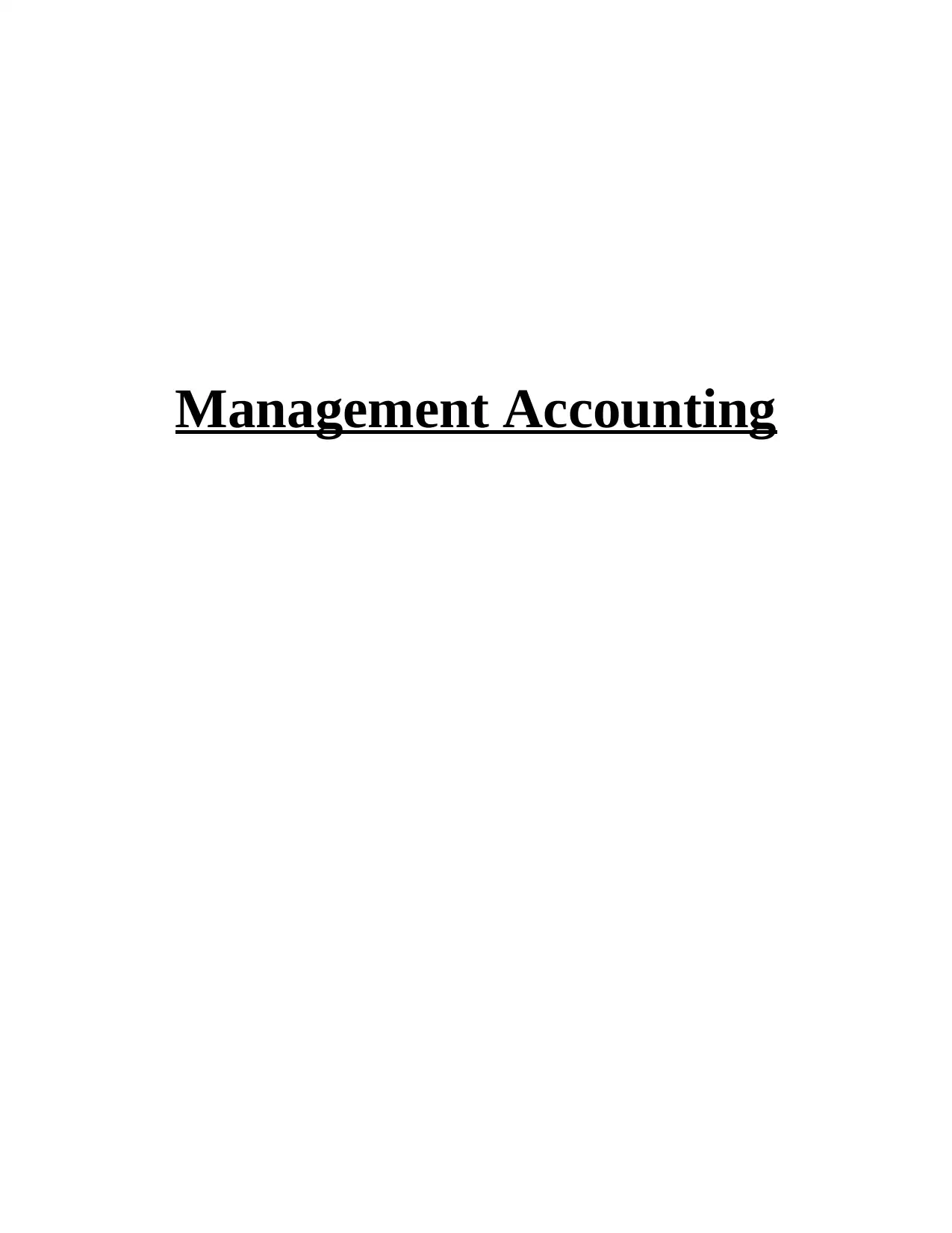
Management Accounting
Paraphrase This Document
Need a fresh take? Get an instant paraphrase of this document with our AI Paraphraser
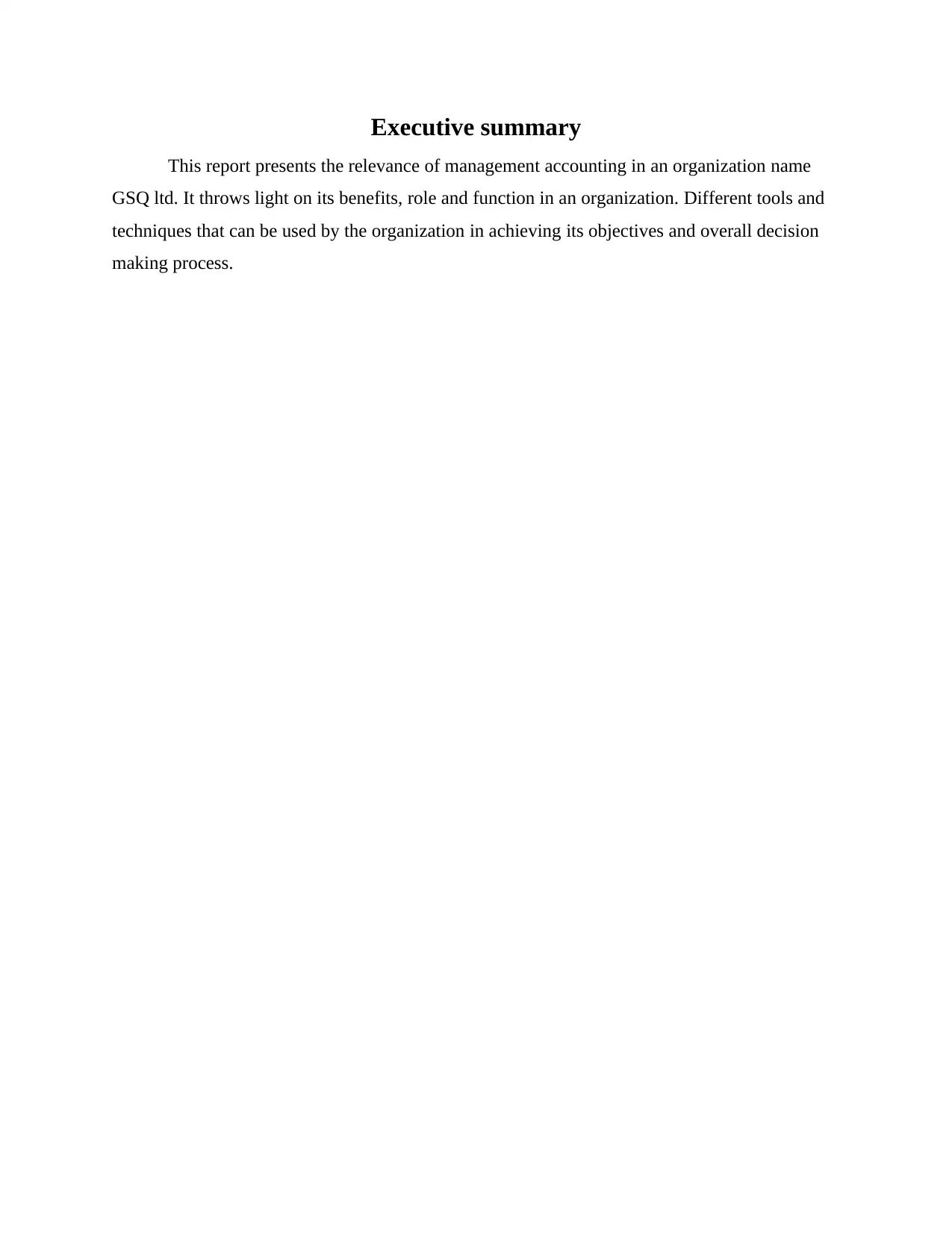
Executive summary
This report presents the relevance of management accounting in an organization name
GSQ ltd. It throws light on its benefits, role and function in an organization. Different tools and
techniques that can be used by the organization in achieving its objectives and overall decision
making process.
This report presents the relevance of management accounting in an organization name
GSQ ltd. It throws light on its benefits, role and function in an organization. Different tools and
techniques that can be used by the organization in achieving its objectives and overall decision
making process.
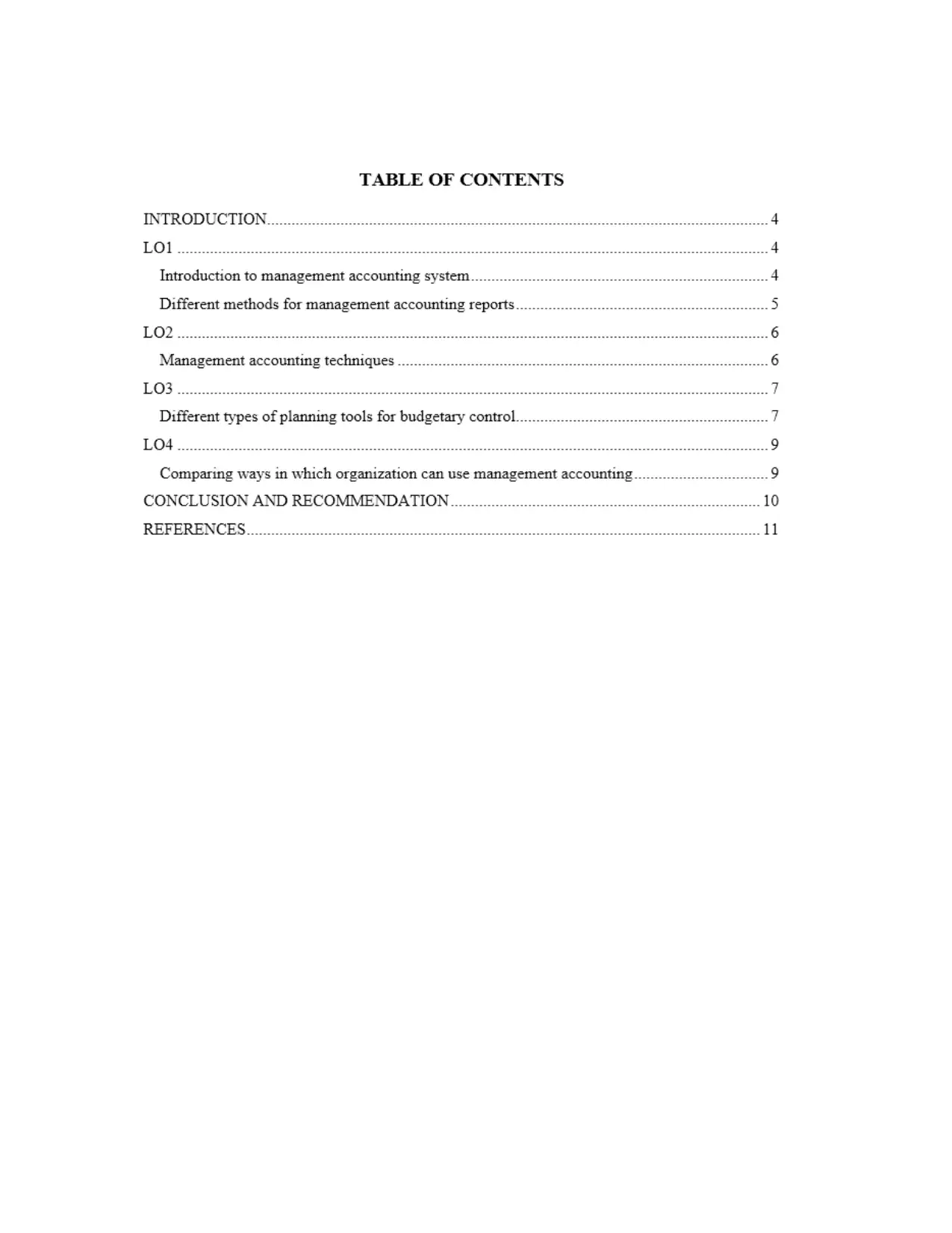
⊘ This is a preview!⊘
Do you want full access?
Subscribe today to unlock all pages.

Trusted by 1+ million students worldwide
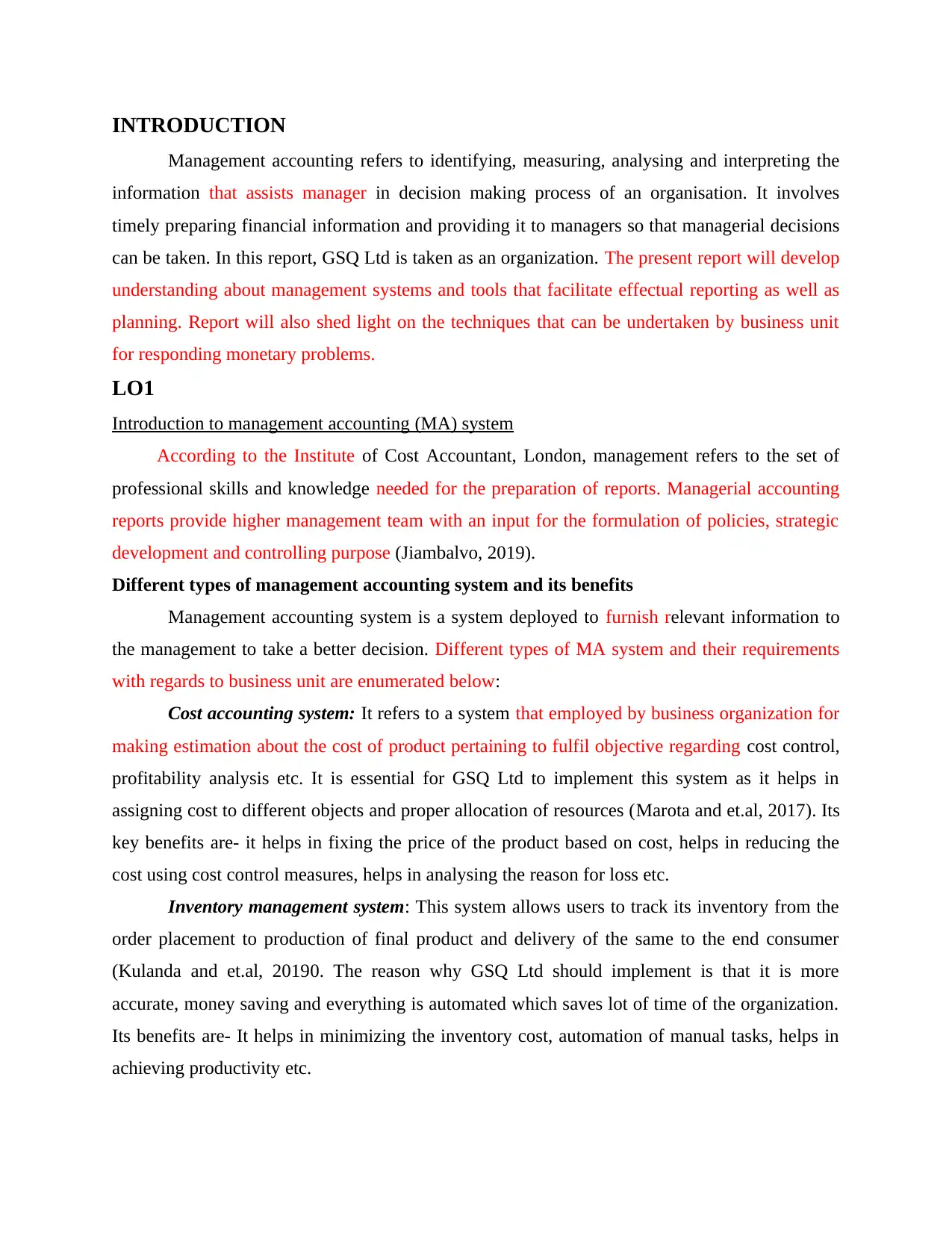
INTRODUCTION
Management accounting refers to identifying, measuring, analysing and interpreting the
information that assists manager in decision making process of an organisation. It involves
timely preparing financial information and providing it to managers so that managerial decisions
can be taken. In this report, GSQ Ltd is taken as an organization. The present report will develop
understanding about management systems and tools that facilitate effectual reporting as well as
planning. Report will also shed light on the techniques that can be undertaken by business unit
for responding monetary problems.
LO1
Introduction to management accounting (MA) system
According to the Institute of Cost Accountant, London, management refers to the set of
professional skills and knowledge needed for the preparation of reports. Managerial accounting
reports provide higher management team with an input for the formulation of policies, strategic
development and controlling purpose (Jiambalvo, 2019).
Different types of management accounting system and its benefits
Management accounting system is a system deployed to furnish relevant information to
the management to take a better decision. Different types of MA system and their requirements
with regards to business unit are enumerated below:
Cost accounting system: It refers to a system that employed by business organization for
making estimation about the cost of product pertaining to fulfil objective regarding cost control,
profitability analysis etc. It is essential for GSQ Ltd to implement this system as it helps in
assigning cost to different objects and proper allocation of resources (Marota and et.al, 2017). Its
key benefits are- it helps in fixing the price of the product based on cost, helps in reducing the
cost using cost control measures, helps in analysing the reason for loss etc.
Inventory management system: This system allows users to track its inventory from the
order placement to production of final product and delivery of the same to the end consumer
(Kulanda and et.al, 20190. The reason why GSQ Ltd should implement is that it is more
accurate, money saving and everything is automated which saves lot of time of the organization.
Its benefits are- It helps in minimizing the inventory cost, automation of manual tasks, helps in
achieving productivity etc.
Management accounting refers to identifying, measuring, analysing and interpreting the
information that assists manager in decision making process of an organisation. It involves
timely preparing financial information and providing it to managers so that managerial decisions
can be taken. In this report, GSQ Ltd is taken as an organization. The present report will develop
understanding about management systems and tools that facilitate effectual reporting as well as
planning. Report will also shed light on the techniques that can be undertaken by business unit
for responding monetary problems.
LO1
Introduction to management accounting (MA) system
According to the Institute of Cost Accountant, London, management refers to the set of
professional skills and knowledge needed for the preparation of reports. Managerial accounting
reports provide higher management team with an input for the formulation of policies, strategic
development and controlling purpose (Jiambalvo, 2019).
Different types of management accounting system and its benefits
Management accounting system is a system deployed to furnish relevant information to
the management to take a better decision. Different types of MA system and their requirements
with regards to business unit are enumerated below:
Cost accounting system: It refers to a system that employed by business organization for
making estimation about the cost of product pertaining to fulfil objective regarding cost control,
profitability analysis etc. It is essential for GSQ Ltd to implement this system as it helps in
assigning cost to different objects and proper allocation of resources (Marota and et.al, 2017). Its
key benefits are- it helps in fixing the price of the product based on cost, helps in reducing the
cost using cost control measures, helps in analysing the reason for loss etc.
Inventory management system: This system allows users to track its inventory from the
order placement to production of final product and delivery of the same to the end consumer
(Kulanda and et.al, 20190. The reason why GSQ Ltd should implement is that it is more
accurate, money saving and everything is automated which saves lot of time of the organization.
Its benefits are- It helps in minimizing the inventory cost, automation of manual tasks, helps in
achieving productivity etc.
Paraphrase This Document
Need a fresh take? Get an instant paraphrase of this document with our AI Paraphraser
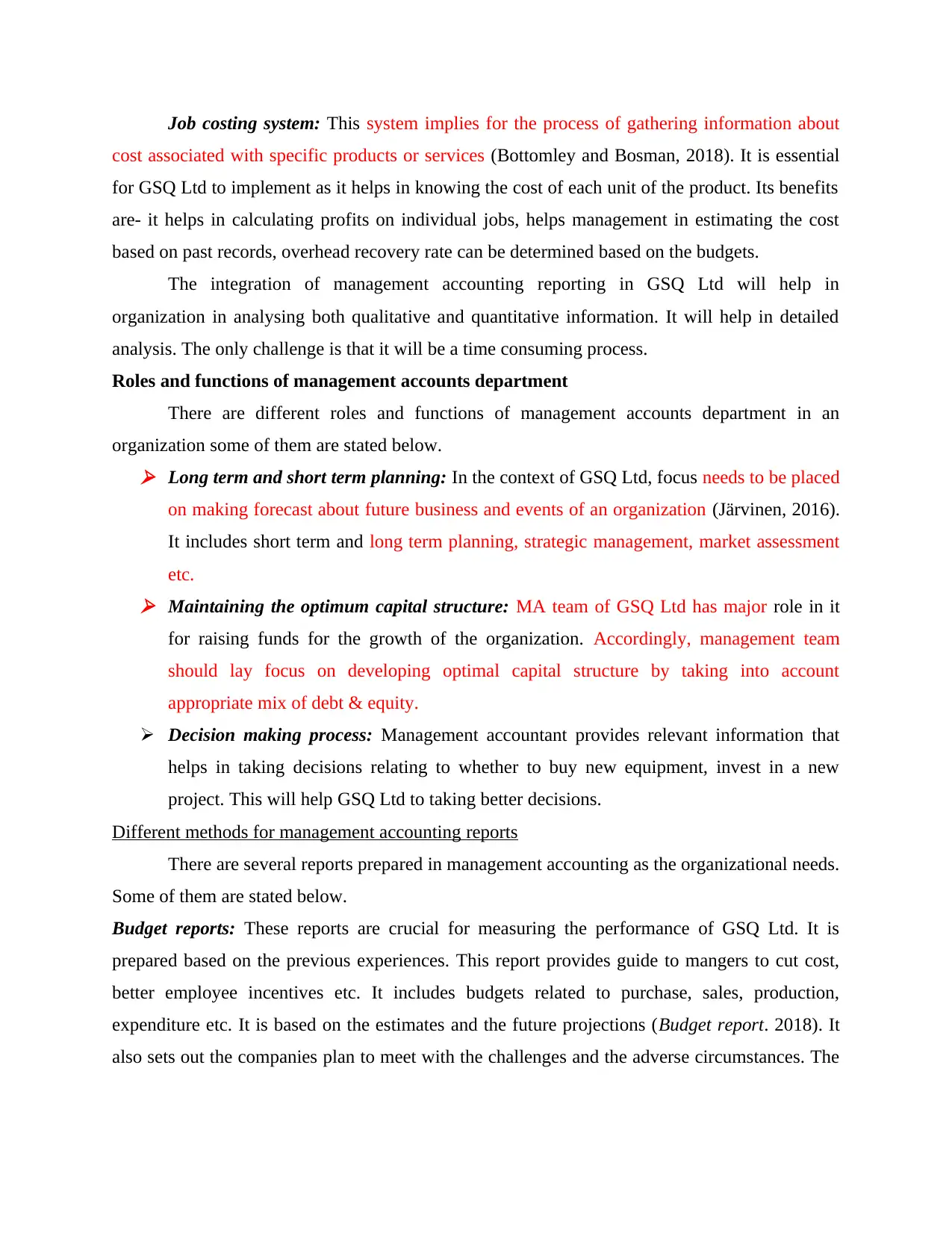
Job costing system: This system implies for the process of gathering information about
cost associated with specific products or services (Bottomley and Bosman, 2018). It is essential
for GSQ Ltd to implement as it helps in knowing the cost of each unit of the product. Its benefits
are- it helps in calculating profits on individual jobs, helps management in estimating the cost
based on past records, overhead recovery rate can be determined based on the budgets.
The integration of management accounting reporting in GSQ Ltd will help in
organization in analysing both qualitative and quantitative information. It will help in detailed
analysis. The only challenge is that it will be a time consuming process.
Roles and functions of management accounts department
There are different roles and functions of management accounts department in an
organization some of them are stated below. Long term and short term planning: In the context of GSQ Ltd, focus needs to be placed
on making forecast about future business and events of an organization (Järvinen, 2016).
It includes short term and long term planning, strategic management, market assessment
etc. Maintaining the optimum capital structure: MA team of GSQ Ltd has major role in it
for raising funds for the growth of the organization. Accordingly, management team
should lay focus on developing optimal capital structure by taking into account
appropriate mix of debt & equity.
Decision making process: Management accountant provides relevant information that
helps in taking decisions relating to whether to buy new equipment, invest in a new
project. This will help GSQ Ltd to taking better decisions.
Different methods for management accounting reports
There are several reports prepared in management accounting as the organizational needs.
Some of them are stated below.
Budget reports: These reports are crucial for measuring the performance of GSQ Ltd. It is
prepared based on the previous experiences. This report provides guide to mangers to cut cost,
better employee incentives etc. It includes budgets related to purchase, sales, production,
expenditure etc. It is based on the estimates and the future projections (Budget report. 2018). It
also sets out the companies plan to meet with the challenges and the adverse circumstances. The
cost associated with specific products or services (Bottomley and Bosman, 2018). It is essential
for GSQ Ltd to implement as it helps in knowing the cost of each unit of the product. Its benefits
are- it helps in calculating profits on individual jobs, helps management in estimating the cost
based on past records, overhead recovery rate can be determined based on the budgets.
The integration of management accounting reporting in GSQ Ltd will help in
organization in analysing both qualitative and quantitative information. It will help in detailed
analysis. The only challenge is that it will be a time consuming process.
Roles and functions of management accounts department
There are different roles and functions of management accounts department in an
organization some of them are stated below. Long term and short term planning: In the context of GSQ Ltd, focus needs to be placed
on making forecast about future business and events of an organization (Järvinen, 2016).
It includes short term and long term planning, strategic management, market assessment
etc. Maintaining the optimum capital structure: MA team of GSQ Ltd has major role in it
for raising funds for the growth of the organization. Accordingly, management team
should lay focus on developing optimal capital structure by taking into account
appropriate mix of debt & equity.
Decision making process: Management accountant provides relevant information that
helps in taking decisions relating to whether to buy new equipment, invest in a new
project. This will help GSQ Ltd to taking better decisions.
Different methods for management accounting reports
There are several reports prepared in management accounting as the organizational needs.
Some of them are stated below.
Budget reports: These reports are crucial for measuring the performance of GSQ Ltd. It is
prepared based on the previous experiences. This report provides guide to mangers to cut cost,
better employee incentives etc. It includes budgets related to purchase, sales, production,
expenditure etc. It is based on the estimates and the future projections (Budget report. 2018). It
also sets out the companies plan to meet with the challenges and the adverse circumstances. The
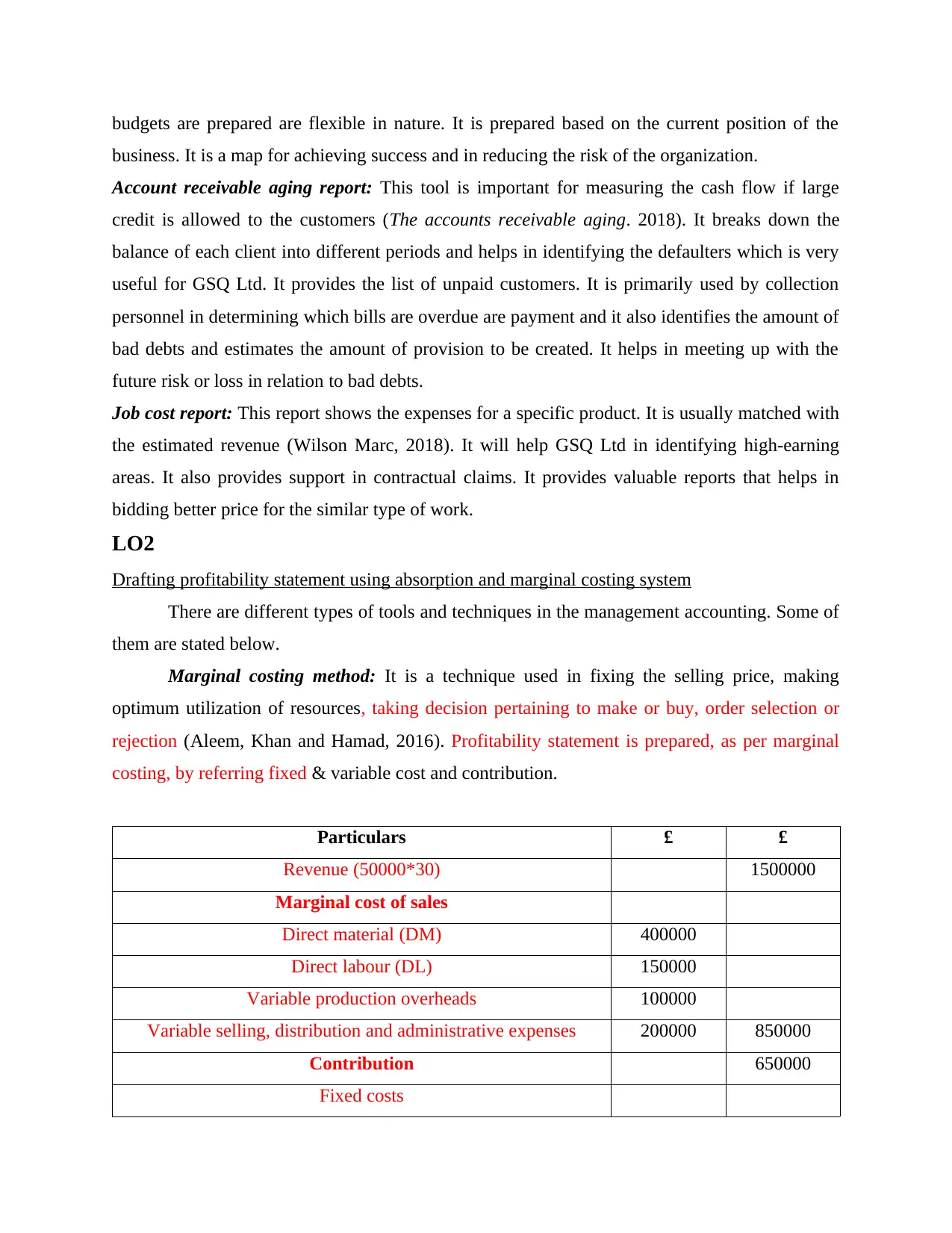
budgets are prepared are flexible in nature. It is prepared based on the current position of the
business. It is a map for achieving success and in reducing the risk of the organization.
Account receivable aging report: This tool is important for measuring the cash flow if large
credit is allowed to the customers (The accounts receivable aging. 2018). It breaks down the
balance of each client into different periods and helps in identifying the defaulters which is very
useful for GSQ Ltd. It provides the list of unpaid customers. It is primarily used by collection
personnel in determining which bills are overdue are payment and it also identifies the amount of
bad debts and estimates the amount of provision to be created. It helps in meeting up with the
future risk or loss in relation to bad debts.
Job cost report: This report shows the expenses for a specific product. It is usually matched with
the estimated revenue (Wilson Marc, 2018). It will help GSQ Ltd in identifying high-earning
areas. It also provides support in contractual claims. It provides valuable reports that helps in
bidding better price for the similar type of work.
LO2
Drafting profitability statement using absorption and marginal costing system
There are different types of tools and techniques in the management accounting. Some of
them are stated below.
Marginal costing method: It is a technique used in fixing the selling price, making
optimum utilization of resources, taking decision pertaining to make or buy, order selection or
rejection (Aleem, Khan and Hamad, 2016). Profitability statement is prepared, as per marginal
costing, by referring fixed & variable cost and contribution.
Particulars £ £
Revenue (50000*30) 1500000
Marginal cost of sales
Direct material (DM) 400000
Direct labour (DL) 150000
Variable production overheads 100000
Variable selling, distribution and administrative expenses 200000 850000
Contribution 650000
Fixed costs
business. It is a map for achieving success and in reducing the risk of the organization.
Account receivable aging report: This tool is important for measuring the cash flow if large
credit is allowed to the customers (The accounts receivable aging. 2018). It breaks down the
balance of each client into different periods and helps in identifying the defaulters which is very
useful for GSQ Ltd. It provides the list of unpaid customers. It is primarily used by collection
personnel in determining which bills are overdue are payment and it also identifies the amount of
bad debts and estimates the amount of provision to be created. It helps in meeting up with the
future risk or loss in relation to bad debts.
Job cost report: This report shows the expenses for a specific product. It is usually matched with
the estimated revenue (Wilson Marc, 2018). It will help GSQ Ltd in identifying high-earning
areas. It also provides support in contractual claims. It provides valuable reports that helps in
bidding better price for the similar type of work.
LO2
Drafting profitability statement using absorption and marginal costing system
There are different types of tools and techniques in the management accounting. Some of
them are stated below.
Marginal costing method: It is a technique used in fixing the selling price, making
optimum utilization of resources, taking decision pertaining to make or buy, order selection or
rejection (Aleem, Khan and Hamad, 2016). Profitability statement is prepared, as per marginal
costing, by referring fixed & variable cost and contribution.
Particulars £ £
Revenue (50000*30) 1500000
Marginal cost of sales
Direct material (DM) 400000
Direct labour (DL) 150000
Variable production overheads 100000
Variable selling, distribution and administrative expenses 200000 850000
Contribution 650000
Fixed costs
⊘ This is a preview!⊘
Do you want full access?
Subscribe today to unlock all pages.

Trusted by 1+ million students worldwide
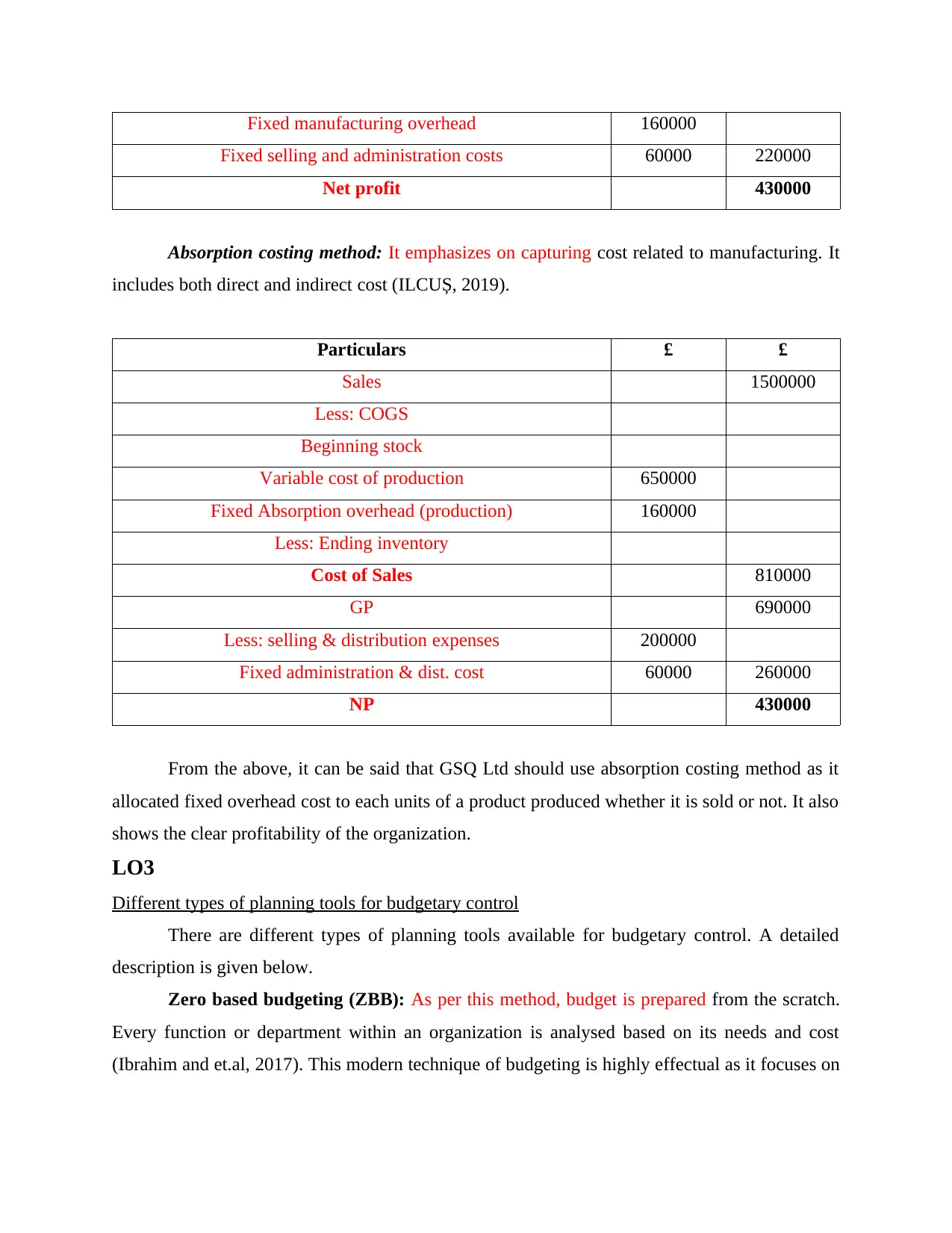
Fixed manufacturing overhead 160000
Fixed selling and administration costs 60000 220000
Net profit 430000
Absorption costing method: It emphasizes on capturing cost related to manufacturing. It
includes both direct and indirect cost (ILCUȘ, 2019).
Particulars £ £
Sales 1500000
Less: COGS
Beginning stock
Variable cost of production 650000
Fixed Absorption overhead (production) 160000
Less: Ending inventory
Cost of Sales 810000
GP 690000
Less: selling & distribution expenses 200000
Fixed administration & dist. cost 60000 260000
NP 430000
From the above, it can be said that GSQ Ltd should use absorption costing method as it
allocated fixed overhead cost to each units of a product produced whether it is sold or not. It also
shows the clear profitability of the organization.
LO3
Different types of planning tools for budgetary control
There are different types of planning tools available for budgetary control. A detailed
description is given below.
Zero based budgeting (ZBB): As per this method, budget is prepared from the scratch.
Every function or department within an organization is analysed based on its needs and cost
(Ibrahim and et.al, 2017). This modern technique of budgeting is highly effectual as it focuses on
Fixed selling and administration costs 60000 220000
Net profit 430000
Absorption costing method: It emphasizes on capturing cost related to manufacturing. It
includes both direct and indirect cost (ILCUȘ, 2019).
Particulars £ £
Sales 1500000
Less: COGS
Beginning stock
Variable cost of production 650000
Fixed Absorption overhead (production) 160000
Less: Ending inventory
Cost of Sales 810000
GP 690000
Less: selling & distribution expenses 200000
Fixed administration & dist. cost 60000 260000
NP 430000
From the above, it can be said that GSQ Ltd should use absorption costing method as it
allocated fixed overhead cost to each units of a product produced whether it is sold or not. It also
shows the clear profitability of the organization.
LO3
Different types of planning tools for budgetary control
There are different types of planning tools available for budgetary control. A detailed
description is given below.
Zero based budgeting (ZBB): As per this method, budget is prepared from the scratch.
Every function or department within an organization is analysed based on its needs and cost
(Ibrahim and et.al, 2017). This modern technique of budgeting is highly effectual as it focuses on
Paraphrase This Document
Need a fresh take? Get an instant paraphrase of this document with our AI Paraphraser
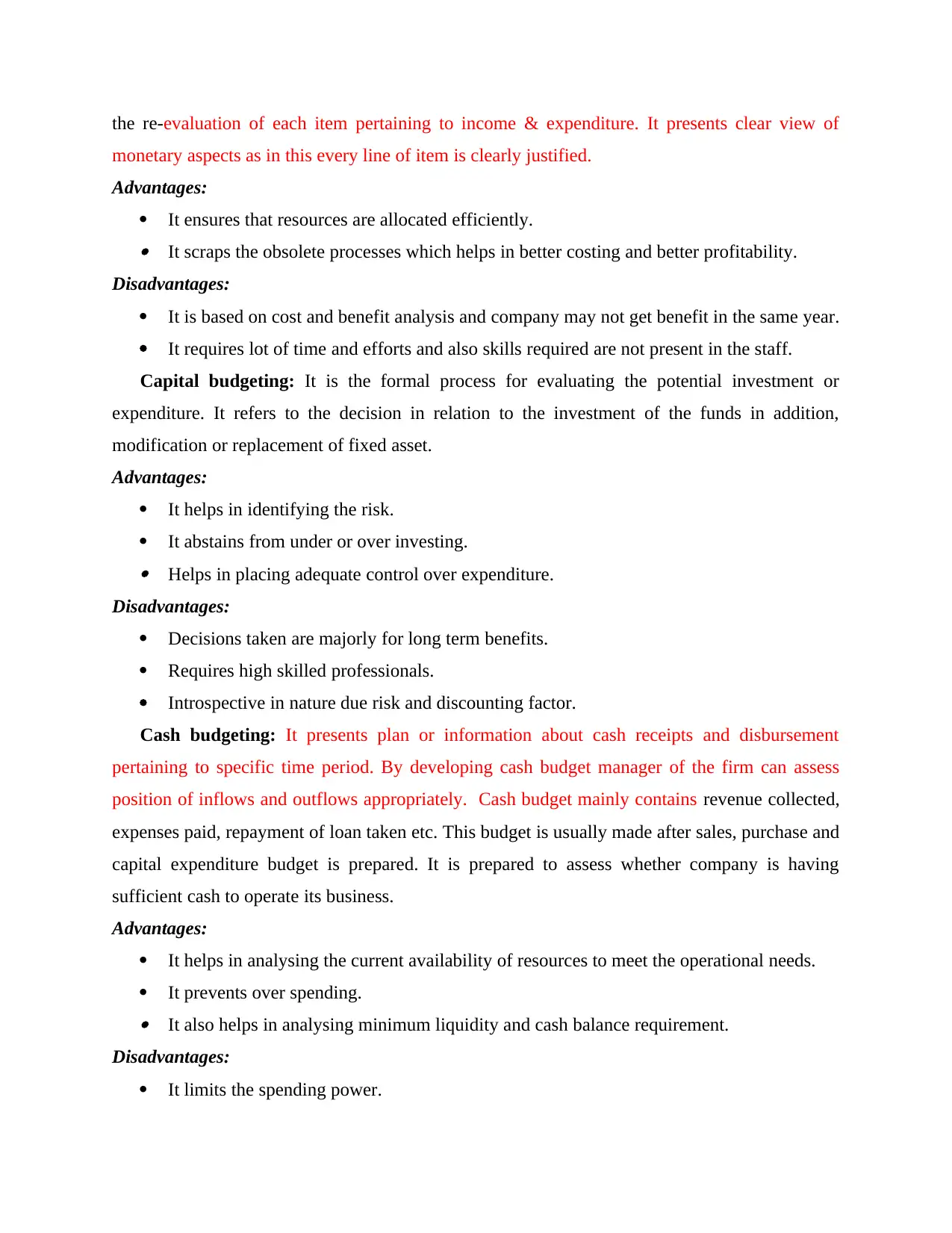
the re-evaluation of each item pertaining to income & expenditure. It presents clear view of
monetary aspects as in this every line of item is clearly justified.
Advantages:
It ensures that resources are allocated efficiently. It scraps the obsolete processes which helps in better costing and better profitability.
Disadvantages:
It is based on cost and benefit analysis and company may not get benefit in the same year.
It requires lot of time and efforts and also skills required are not present in the staff.
Capital budgeting: It is the formal process for evaluating the potential investment or
expenditure. It refers to the decision in relation to the investment of the funds in addition,
modification or replacement of fixed asset.
Advantages:
It helps in identifying the risk.
It abstains from under or over investing. Helps in placing adequate control over expenditure.
Disadvantages:
Decisions taken are majorly for long term benefits.
Requires high skilled professionals.
Introspective in nature due risk and discounting factor.
Cash budgeting: It presents plan or information about cash receipts and disbursement
pertaining to specific time period. By developing cash budget manager of the firm can assess
position of inflows and outflows appropriately. Cash budget mainly contains revenue collected,
expenses paid, repayment of loan taken etc. This budget is usually made after sales, purchase and
capital expenditure budget is prepared. It is prepared to assess whether company is having
sufficient cash to operate its business.
Advantages:
It helps in analysing the current availability of resources to meet the operational needs.
It prevents over spending. It also helps in analysing minimum liquidity and cash balance requirement.
Disadvantages:
It limits the spending power.
monetary aspects as in this every line of item is clearly justified.
Advantages:
It ensures that resources are allocated efficiently. It scraps the obsolete processes which helps in better costing and better profitability.
Disadvantages:
It is based on cost and benefit analysis and company may not get benefit in the same year.
It requires lot of time and efforts and also skills required are not present in the staff.
Capital budgeting: It is the formal process for evaluating the potential investment or
expenditure. It refers to the decision in relation to the investment of the funds in addition,
modification or replacement of fixed asset.
Advantages:
It helps in identifying the risk.
It abstains from under or over investing. Helps in placing adequate control over expenditure.
Disadvantages:
Decisions taken are majorly for long term benefits.
Requires high skilled professionals.
Introspective in nature due risk and discounting factor.
Cash budgeting: It presents plan or information about cash receipts and disbursement
pertaining to specific time period. By developing cash budget manager of the firm can assess
position of inflows and outflows appropriately. Cash budget mainly contains revenue collected,
expenses paid, repayment of loan taken etc. This budget is usually made after sales, purchase and
capital expenditure budget is prepared. It is prepared to assess whether company is having
sufficient cash to operate its business.
Advantages:
It helps in analysing the current availability of resources to meet the operational needs.
It prevents over spending. It also helps in analysing minimum liquidity and cash balance requirement.
Disadvantages:
It limits the spending power.
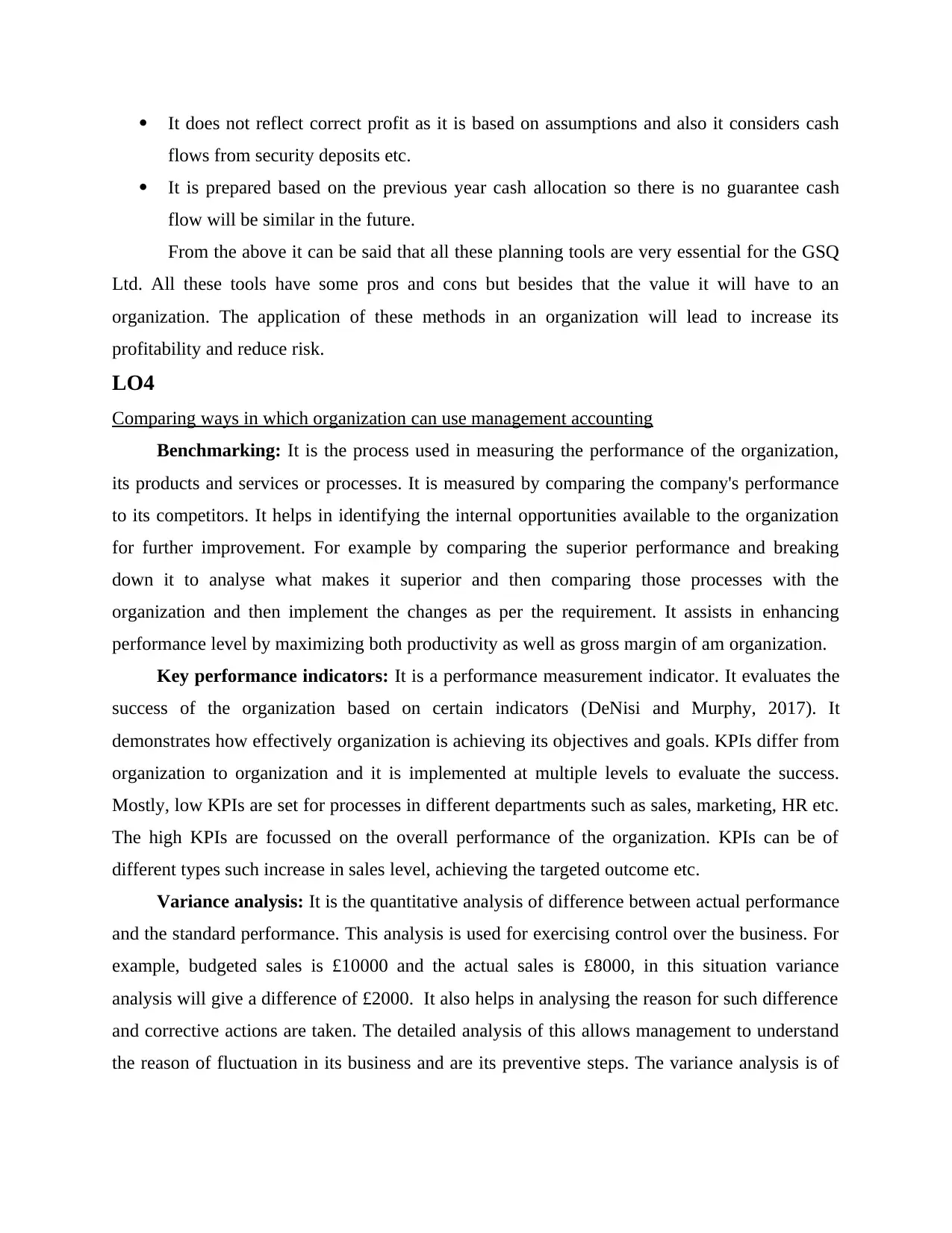
It does not reflect correct profit as it is based on assumptions and also it considers cash
flows from security deposits etc.
It is prepared based on the previous year cash allocation so there is no guarantee cash
flow will be similar in the future.
From the above it can be said that all these planning tools are very essential for the GSQ
Ltd. All these tools have some pros and cons but besides that the value it will have to an
organization. The application of these methods in an organization will lead to increase its
profitability and reduce risk.
LO4
Comparing ways in which organization can use management accounting
Benchmarking: It is the process used in measuring the performance of the organization,
its products and services or processes. It is measured by comparing the company's performance
to its competitors. It helps in identifying the internal opportunities available to the organization
for further improvement. For example by comparing the superior performance and breaking
down it to analyse what makes it superior and then comparing those processes with the
organization and then implement the changes as per the requirement. It assists in enhancing
performance level by maximizing both productivity as well as gross margin of am organization.
Key performance indicators: It is a performance measurement indicator. It evaluates the
success of the organization based on certain indicators (DeNisi and Murphy, 2017). It
demonstrates how effectively organization is achieving its objectives and goals. KPIs differ from
organization to organization and it is implemented at multiple levels to evaluate the success.
Mostly, low KPIs are set for processes in different departments such as sales, marketing, HR etc.
The high KPIs are focussed on the overall performance of the organization. KPIs can be of
different types such increase in sales level, achieving the targeted outcome etc.
Variance analysis: It is the quantitative analysis of difference between actual performance
and the standard performance. This analysis is used for exercising control over the business. For
example, budgeted sales is £10000 and the actual sales is £8000, in this situation variance
analysis will give a difference of £2000. It also helps in analysing the reason for such difference
and corrective actions are taken. The detailed analysis of this allows management to understand
the reason of fluctuation in its business and are its preventive steps. The variance analysis is of
flows from security deposits etc.
It is prepared based on the previous year cash allocation so there is no guarantee cash
flow will be similar in the future.
From the above it can be said that all these planning tools are very essential for the GSQ
Ltd. All these tools have some pros and cons but besides that the value it will have to an
organization. The application of these methods in an organization will lead to increase its
profitability and reduce risk.
LO4
Comparing ways in which organization can use management accounting
Benchmarking: It is the process used in measuring the performance of the organization,
its products and services or processes. It is measured by comparing the company's performance
to its competitors. It helps in identifying the internal opportunities available to the organization
for further improvement. For example by comparing the superior performance and breaking
down it to analyse what makes it superior and then comparing those processes with the
organization and then implement the changes as per the requirement. It assists in enhancing
performance level by maximizing both productivity as well as gross margin of am organization.
Key performance indicators: It is a performance measurement indicator. It evaluates the
success of the organization based on certain indicators (DeNisi and Murphy, 2017). It
demonstrates how effectively organization is achieving its objectives and goals. KPIs differ from
organization to organization and it is implemented at multiple levels to evaluate the success.
Mostly, low KPIs are set for processes in different departments such as sales, marketing, HR etc.
The high KPIs are focussed on the overall performance of the organization. KPIs can be of
different types such increase in sales level, achieving the targeted outcome etc.
Variance analysis: It is the quantitative analysis of difference between actual performance
and the standard performance. This analysis is used for exercising control over the business. For
example, budgeted sales is £10000 and the actual sales is £8000, in this situation variance
analysis will give a difference of £2000. It also helps in analysing the reason for such difference
and corrective actions are taken. The detailed analysis of this allows management to understand
the reason of fluctuation in its business and are its preventive steps. The variance analysis is of
⊘ This is a preview!⊘
Do you want full access?
Subscribe today to unlock all pages.

Trusted by 1+ million students worldwide
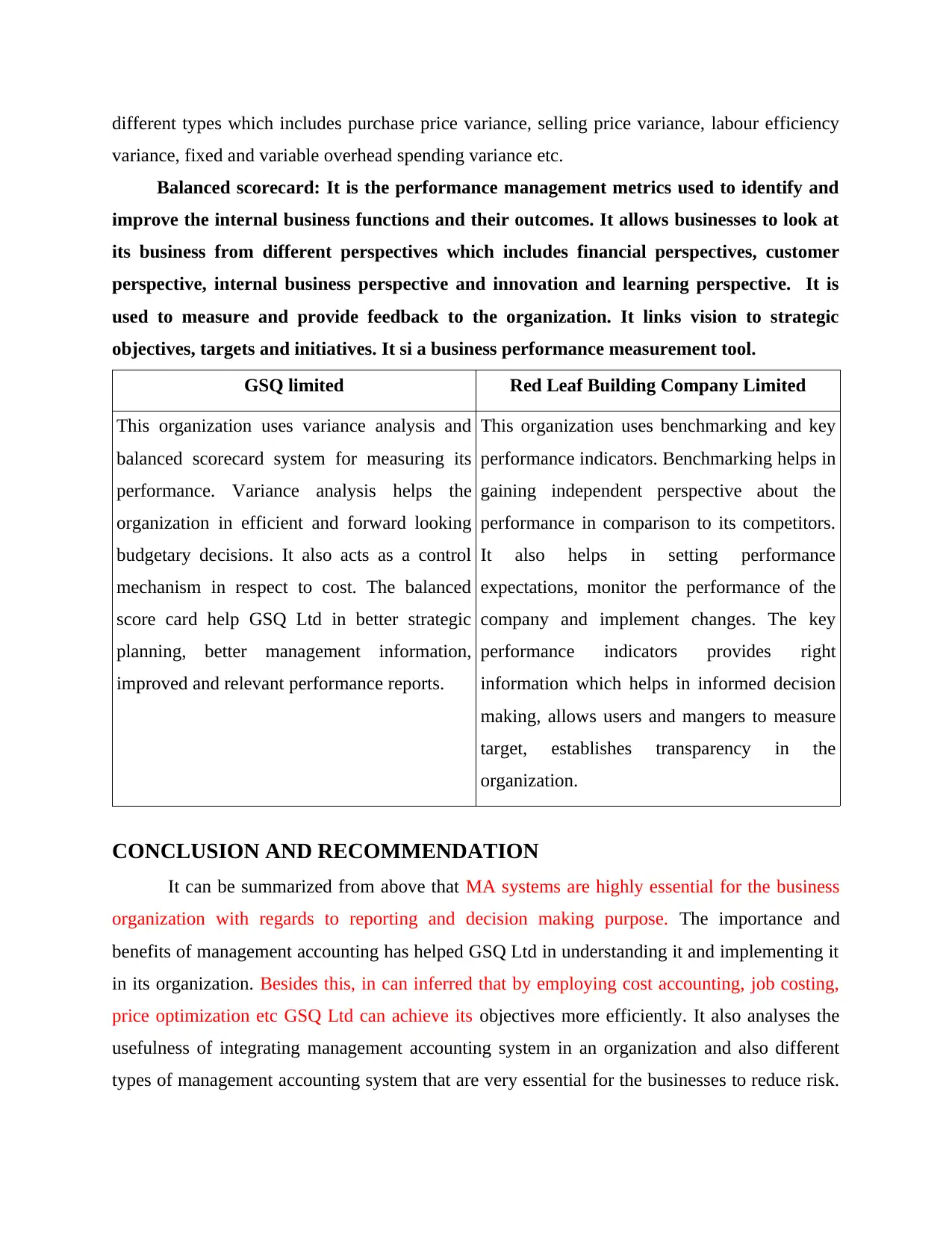
different types which includes purchase price variance, selling price variance, labour efficiency
variance, fixed and variable overhead spending variance etc.
Balanced scorecard: It is the performance management metrics used to identify and
improve the internal business functions and their outcomes. It allows businesses to look at
its business from different perspectives which includes financial perspectives, customer
perspective, internal business perspective and innovation and learning perspective. It is
used to measure and provide feedback to the organization. It links vision to strategic
objectives, targets and initiatives. It si a business performance measurement tool.
GSQ limited Red Leaf Building Company Limited
This organization uses variance analysis and
balanced scorecard system for measuring its
performance. Variance analysis helps the
organization in efficient and forward looking
budgetary decisions. It also acts as a control
mechanism in respect to cost. The balanced
score card help GSQ Ltd in better strategic
planning, better management information,
improved and relevant performance reports.
This organization uses benchmarking and key
performance indicators. Benchmarking helps in
gaining independent perspective about the
performance in comparison to its competitors.
It also helps in setting performance
expectations, monitor the performance of the
company and implement changes. The key
performance indicators provides right
information which helps in informed decision
making, allows users and mangers to measure
target, establishes transparency in the
organization.
CONCLUSION AND RECOMMENDATION
It can be summarized from above that MA systems are highly essential for the business
organization with regards to reporting and decision making purpose. The importance and
benefits of management accounting has helped GSQ Ltd in understanding it and implementing it
in its organization. Besides this, in can inferred that by employing cost accounting, job costing,
price optimization etc GSQ Ltd can achieve its objectives more efficiently. It also analyses the
usefulness of integrating management accounting system in an organization and also different
types of management accounting system that are very essential for the businesses to reduce risk.
variance, fixed and variable overhead spending variance etc.
Balanced scorecard: It is the performance management metrics used to identify and
improve the internal business functions and their outcomes. It allows businesses to look at
its business from different perspectives which includes financial perspectives, customer
perspective, internal business perspective and innovation and learning perspective. It is
used to measure and provide feedback to the organization. It links vision to strategic
objectives, targets and initiatives. It si a business performance measurement tool.
GSQ limited Red Leaf Building Company Limited
This organization uses variance analysis and
balanced scorecard system for measuring its
performance. Variance analysis helps the
organization in efficient and forward looking
budgetary decisions. It also acts as a control
mechanism in respect to cost. The balanced
score card help GSQ Ltd in better strategic
planning, better management information,
improved and relevant performance reports.
This organization uses benchmarking and key
performance indicators. Benchmarking helps in
gaining independent perspective about the
performance in comparison to its competitors.
It also helps in setting performance
expectations, monitor the performance of the
company and implement changes. The key
performance indicators provides right
information which helps in informed decision
making, allows users and mangers to measure
target, establishes transparency in the
organization.
CONCLUSION AND RECOMMENDATION
It can be summarized from above that MA systems are highly essential for the business
organization with regards to reporting and decision making purpose. The importance and
benefits of management accounting has helped GSQ Ltd in understanding it and implementing it
in its organization. Besides this, in can inferred that by employing cost accounting, job costing,
price optimization etc GSQ Ltd can achieve its objectives more efficiently. It also analyses the
usefulness of integrating management accounting system in an organization and also different
types of management accounting system that are very essential for the businesses to reduce risk.
Paraphrase This Document
Need a fresh take? Get an instant paraphrase of this document with our AI Paraphraser
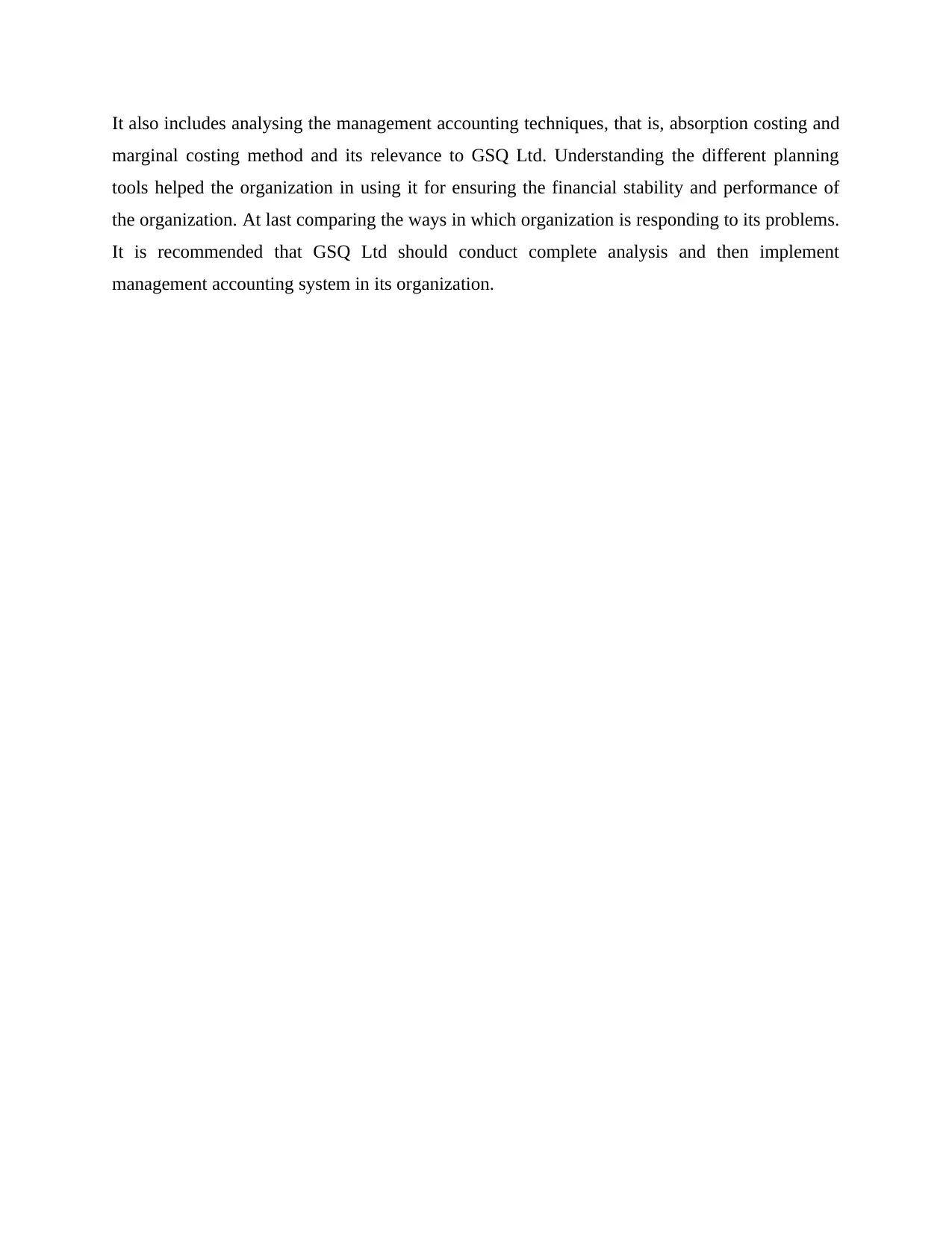
It also includes analysing the management accounting techniques, that is, absorption costing and
marginal costing method and its relevance to GSQ Ltd. Understanding the different planning
tools helped the organization in using it for ensuring the financial stability and performance of
the organization. At last comparing the ways in which organization is responding to its problems.
It is recommended that GSQ Ltd should conduct complete analysis and then implement
management accounting system in its organization.
marginal costing method and its relevance to GSQ Ltd. Understanding the different planning
tools helped the organization in using it for ensuring the financial stability and performance of
the organization. At last comparing the ways in which organization is responding to its problems.
It is recommended that GSQ Ltd should conduct complete analysis and then implement
management accounting system in its organization.
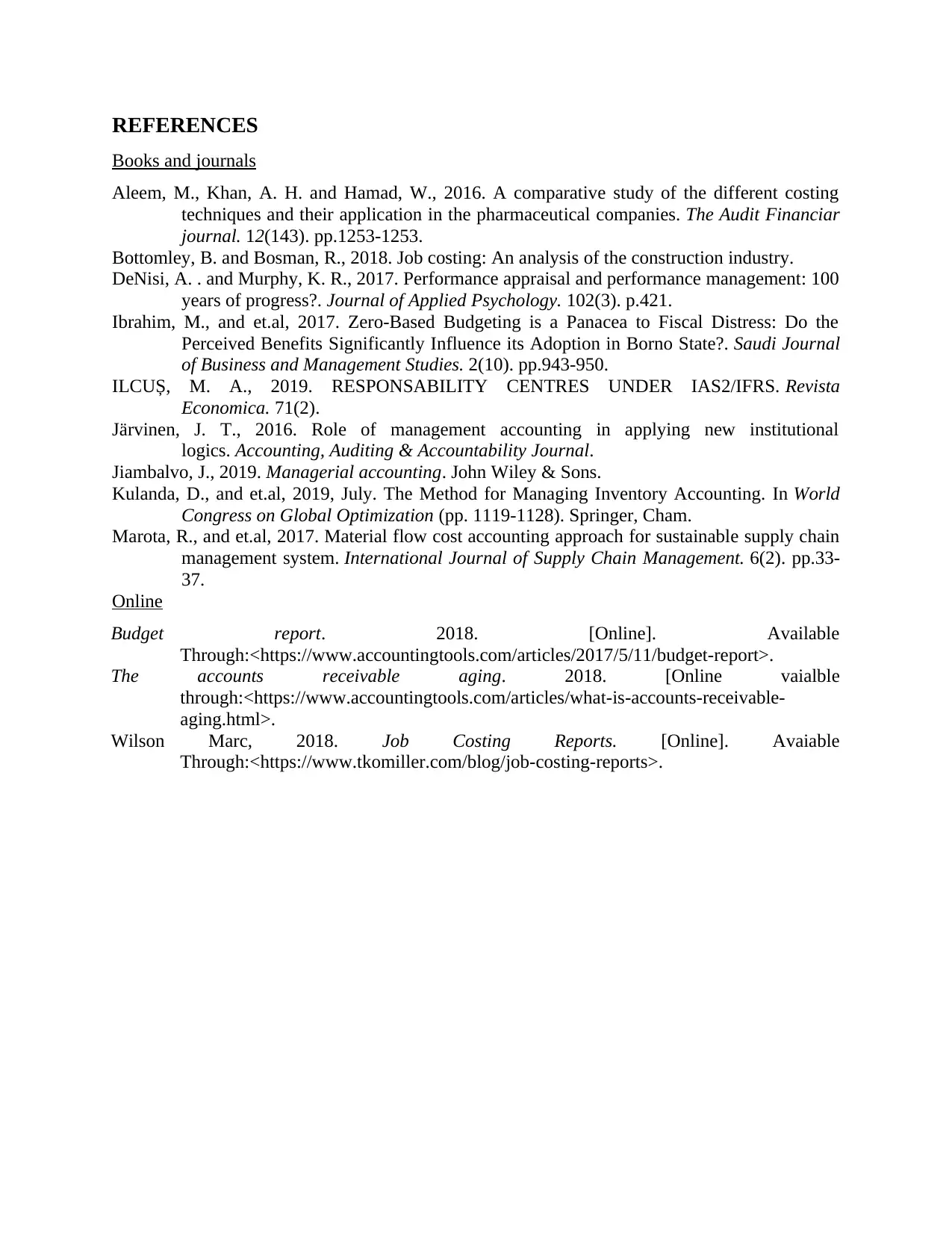
REFERENCES
Books and journals
Aleem, M., Khan, A. H. and Hamad, W., 2016. A comparative study of the different costing
techniques and their application in the pharmaceutical companies. The Audit Financiar
journal. 12(143). pp.1253-1253.
Bottomley, B. and Bosman, R., 2018. Job costing: An analysis of the construction industry.
DeNisi, A. . and Murphy, K. R., 2017. Performance appraisal and performance management: 100
years of progress?. Journal of Applied Psychology. 102(3). p.421.
Ibrahim, M., and et.al, 2017. Zero-Based Budgeting is a Panacea to Fiscal Distress: Do the
Perceived Benefits Significantly Influence its Adoption in Borno State?. Saudi Journal
of Business and Management Studies. 2(10). pp.943-950.
ILCUȘ, M. A., 2019. RESPONSABILITY CENTRES UNDER IAS2/IFRS. Revista
Economica. 71(2).
Järvinen, J. T., 2016. Role of management accounting in applying new institutional
logics. Accounting, Auditing & Accountability Journal.
Jiambalvo, J., 2019. Managerial accounting. John Wiley & Sons.
Kulanda, D., and et.al, 2019, July. The Method for Managing Inventory Accounting. In World
Congress on Global Optimization (pp. 1119-1128). Springer, Cham.
Marota, R., and et.al, 2017. Material flow cost accounting approach for sustainable supply chain
management system. International Journal of Supply Chain Management. 6(2). pp.33-
37.
Online
Budget report. 2018. [Online]. Available
Through:<https://www.accountingtools.com/articles/2017/5/11/budget-report>.
The accounts receivable aging. 2018. [Online vaialble
through:<https://www.accountingtools.com/articles/what-is-accounts-receivable-
aging.html>.
Wilson Marc, 2018. Job Costing Reports. [Online]. Avaiable
Through:<https://www.tkomiller.com/blog/job-costing-reports>.
Books and journals
Aleem, M., Khan, A. H. and Hamad, W., 2016. A comparative study of the different costing
techniques and their application in the pharmaceutical companies. The Audit Financiar
journal. 12(143). pp.1253-1253.
Bottomley, B. and Bosman, R., 2018. Job costing: An analysis of the construction industry.
DeNisi, A. . and Murphy, K. R., 2017. Performance appraisal and performance management: 100
years of progress?. Journal of Applied Psychology. 102(3). p.421.
Ibrahim, M., and et.al, 2017. Zero-Based Budgeting is a Panacea to Fiscal Distress: Do the
Perceived Benefits Significantly Influence its Adoption in Borno State?. Saudi Journal
of Business and Management Studies. 2(10). pp.943-950.
ILCUȘ, M. A., 2019. RESPONSABILITY CENTRES UNDER IAS2/IFRS. Revista
Economica. 71(2).
Järvinen, J. T., 2016. Role of management accounting in applying new institutional
logics. Accounting, Auditing & Accountability Journal.
Jiambalvo, J., 2019. Managerial accounting. John Wiley & Sons.
Kulanda, D., and et.al, 2019, July. The Method for Managing Inventory Accounting. In World
Congress on Global Optimization (pp. 1119-1128). Springer, Cham.
Marota, R., and et.al, 2017. Material flow cost accounting approach for sustainable supply chain
management system. International Journal of Supply Chain Management. 6(2). pp.33-
37.
Online
Budget report. 2018. [Online]. Available
Through:<https://www.accountingtools.com/articles/2017/5/11/budget-report>.
The accounts receivable aging. 2018. [Online vaialble
through:<https://www.accountingtools.com/articles/what-is-accounts-receivable-
aging.html>.
Wilson Marc, 2018. Job Costing Reports. [Online]. Avaiable
Through:<https://www.tkomiller.com/blog/job-costing-reports>.
⊘ This is a preview!⊘
Do you want full access?
Subscribe today to unlock all pages.

Trusted by 1+ million students worldwide
1 out of 13
Related Documents
Your All-in-One AI-Powered Toolkit for Academic Success.
+13062052269
info@desklib.com
Available 24*7 on WhatsApp / Email
![[object Object]](/_next/static/media/star-bottom.7253800d.svg)
Unlock your academic potential
Copyright © 2020–2025 A2Z Services. All Rights Reserved. Developed and managed by ZUCOL.





